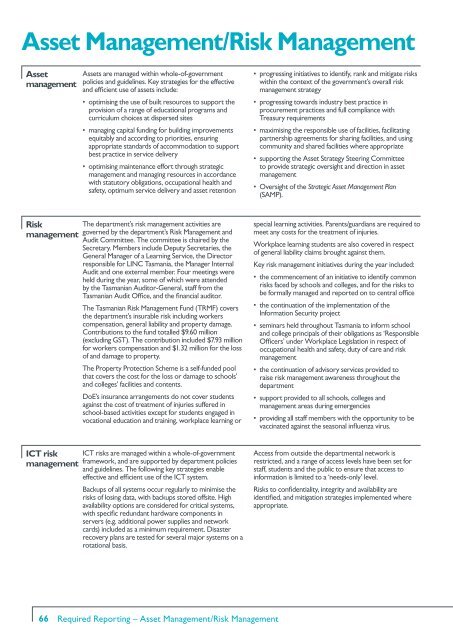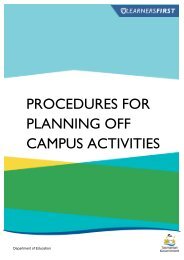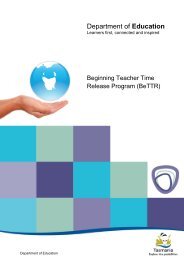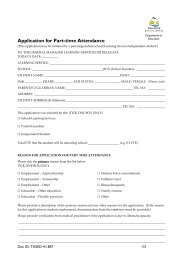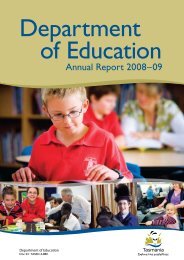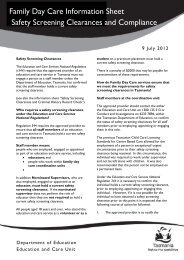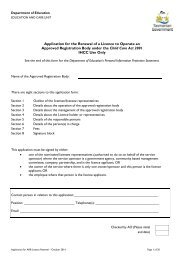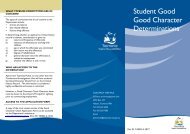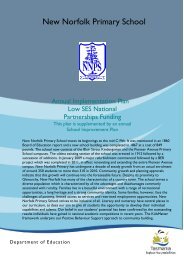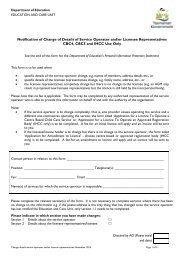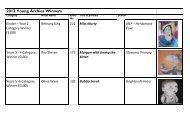Department of Education
DoE Annual Report 2010-2011 - Department of Education
DoE Annual Report 2010-2011 - Department of Education
- No tags were found...
Create successful ePaper yourself
Turn your PDF publications into a flip-book with our unique Google optimized e-Paper software.
Asset Management/Risk Management<br />
Asset<br />
management<br />
Assets are managed within whole-<strong>of</strong>-government<br />
policies and guidelines. Key strategies for the effective<br />
and efficient use <strong>of</strong> assets include:<br />
• optimising the use <strong>of</strong> built resources to support the<br />
provision <strong>of</strong> a range <strong>of</strong> educational programs and<br />
curriculum choices at dispersed sites<br />
• managing capital funding for building improvements<br />
equitably and according to priorities, ensuring<br />
appropriate standards <strong>of</strong> accommodation to support<br />
best practice in service delivery<br />
• optimising maintenance effort through strategic<br />
management and managing resources in accordance<br />
with statutory obligations, occupational health and<br />
safety, optimum service delivery and asset retention<br />
• progressing initiatives to identify, rank and mitigate risks<br />
within the context <strong>of</strong> the government’s overall risk<br />
management strategy<br />
• progressing towards industry best practice in<br />
procurement practices and full compliance with<br />
Treasury requirements<br />
• maximising the responsible use <strong>of</strong> facilities, facilitating<br />
partnership agreements for sharing facilities, and using<br />
community and shared facilities where appropriate<br />
• supporting the Asset Strategy Steering Committee<br />
to provide strategic oversight and direction in asset<br />
management<br />
• Oversight <strong>of</strong> the Strategic Asset Management Plan<br />
(SAMP).<br />
Risk<br />
management<br />
The department’s risk management activities are<br />
governed by the department’s Risk Management and<br />
Audit Committee. The committee is chaired by the<br />
Secretary. Members include Deputy Secretaries, the<br />
General Manager <strong>of</strong> a Learning Service, the Director<br />
responsible for LINC Tasmania, the Manager Internal<br />
Audit and one external member. Four meetings were<br />
held during the year, some <strong>of</strong> which were attended<br />
by the Tasmanian Auditor-General, staff from the<br />
Tasmanian Audit Office, and the financial auditor.<br />
The Tasmanian Risk Management Fund (TRMF) covers<br />
the department’s insurable risk including workers<br />
compensation, general liability and property damage.<br />
Contributions to the fund totalled $9.60 million<br />
(excluding GST). The contribution included $7.93 million<br />
for workers compensation and $1.32 million for the loss<br />
<strong>of</strong> and damage to property.<br />
The Property Protection Scheme is a self-funded pool<br />
that covers the cost for the loss or damage to schools’<br />
and colleges’ facilities and contents.<br />
DoE’s insurance arrangements do not cover students<br />
against the cost <strong>of</strong> treatment <strong>of</strong> injuries suffered in<br />
school-based activities except for students engaged in<br />
vocational education and training, workplace learning or<br />
special learning activities. Parents/guardians are required to<br />
meet any costs for the treatment <strong>of</strong> injuries.<br />
Workplace learning students are also covered in respect<br />
<strong>of</strong> general liability claims brought against them.<br />
Key risk management initiatives during the year included:<br />
• the commencement <strong>of</strong> an initiative to identify common<br />
risks faced by schools and colleges, and for the risks to<br />
be formally managed and reported on to central <strong>of</strong>fice<br />
• the continuation <strong>of</strong> the implementation <strong>of</strong> the<br />
Information Security project<br />
• seminars held throughout Tasmania to inform school<br />
and college principals <strong>of</strong> their obligations as ‘Responsible<br />
Officers’ under Workplace Legislation in respect <strong>of</strong><br />
occupational health and safety, duty <strong>of</strong> care and risk<br />
management<br />
• the continuation <strong>of</strong> advisory services provided to<br />
raise risk management awareness throughout the<br />
department<br />
• support provided to all schools, colleges and<br />
management areas during emergencies<br />
• providing all staff members with the opportunity to be<br />
vaccinated against the seasonal influenza virus.<br />
ICT risk<br />
management<br />
ICT risks are managed within a whole-<strong>of</strong>-government<br />
framework, and are supported by department policies<br />
and guidelines. The following key strategies enable<br />
effective and efficient use <strong>of</strong> the ICT system.<br />
Backups <strong>of</strong> all systems occur regularly to minimise the<br />
risks <strong>of</strong> losing data, with backups stored <strong>of</strong>fsite. High<br />
availability options are considered for critical systems,<br />
with specific redundant hardware components in<br />
servers (e.g. additional power supplies and network<br />
cards) included as a minimum requirement. Disaster<br />
recovery plans are tested for several major systems on a<br />
rotational basis.<br />
Access from outside the departmental network is<br />
restricted, and a range <strong>of</strong> access levels have been set for<br />
staff, students and the public to ensure that access to<br />
information is limited to a ‘needs-only’ level.<br />
Risks to confidentiality, integrity and availability are<br />
identified, and mitigation strategies implemented where<br />
appropriate.<br />
66<br />
Required Reporting – Asset Management/Risk Management


